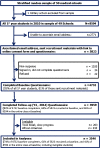Medical School Experiences Associated with Change in Implicit Racial Bias Among 3547 Students: A Medical Student CHANGES Study Report
- PMID: 26129779
- PMCID: PMC4636581
- DOI: 10.1007/s11606-015-3447-7
Medical School Experiences Associated with Change in Implicit Racial Bias Among 3547 Students: A Medical Student CHANGES Study Report
Abstract
Background: Physician implicit (unconscious, automatic) bias has been shown to contribute to racial disparities in medical care. The impact of medical education on implicit racial bias is unknown.
Objective: To examine the association between change in student implicit racial bias towards African Americans and student reports on their experiences with 1) formal curricula related to disparities in health and health care, cultural competence, and/or minority health; 2) informal curricula including racial climate and role model behavior; and 3) the amount and favorability of interracial contact during school.
Design: Prospective observational study involving Web-based questionnaires administered during first (2010) and last (2014) semesters of medical school.
Participants: A total of 3547 students from a stratified random sample of 49 U.S. medical schools.
Main outcome(s) and measure(s): Change in implicit racial attitudes as assessed by the Black-White Implicit Association Test administered during the first semester and again during the last semester of medical school.
Key results: In multivariable modeling, having completed the Black-White Implicit Association Test during medical school remained a statistically significant predictor of decreased implicit racial bias (-5.34, p ≤ 0.001: mixed effects regression with random intercept across schools). Students' self-assessed skills regarding providing care to African American patients had a borderline association with decreased implicit racial bias (-2.18, p = 0.056). Having heard negative comments from attending physicians or residents about African American patients (3.17, p = 0.026) and having had unfavorable vs. very favorable contact with African American physicians (18.79, p = 0.003) were statistically significant predictors of increased implicit racial bias.
Conclusions: Medical school experiences in all three domains were independently associated with change in student implicit racial attitudes. These findings are notable given that even small differences in implicit racial attitudes have been shown to affect behavior and that implicit attitudes are developed over a long period of repeated exposure and are difficult to change.
Keywords: attitude of health personnel; disparities; implicit racial bias; medical education; physician–patient relations.
Comment in
-
Reducing Implicit Bias Through Curricular Interventions.J Gen Intern Med. 2015 Dec;30(12):1726-8. doi: 10.1007/s11606-015-3496-y. J Gen Intern Med. 2015. PMID: 26311199 Free PMC article. No abstract available.
-
Change in Medical Student Implicit Bias.J Gen Intern Med. 2016 Jul;31(7):714. doi: 10.1007/s11606-016-3684-4. J Gen Intern Med. 2016. PMID: 27067346 Free PMC article. No abstract available.
-
Response to Dr. Westfall.J Gen Intern Med. 2016 Jul;31(7):715. doi: 10.1007/s11606-016-3683-5. J Gen Intern Med. 2016. PMID: 27114360 Free PMC article. No abstract available.
References
-
- Smedley BD, Stith AY, Nelson AR. Unequal Treatment: Confronting Racial and Ethnic Disparities in Health Care. Washington: National Academy Press; 2003. - PubMed
Publication types
MeSH terms
Grants and funding
LinkOut - more resources
Full Text Sources
Other Literature Sources


